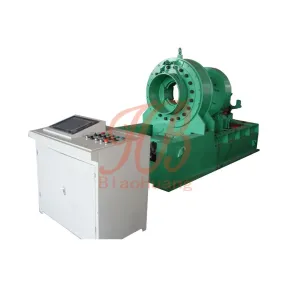Jan. 16, 2025
When buying a bucking machine, it's crucial to make a well-informed choice to guarantee efficiency, reliability, and value for money. Below are seven essential features to think about, each backed by insights from industry experts and practical advice to assist you in your purchasing decision.
Recognizing the capacity of a bucking machine is vital. Capacity refers to the amount of material the equipment can process within a specific timeframe. For instance, industry expert Alex Morrison remarks, “Always pick a machine that surpasses your standard production needs to accommodate peak loads.”
| Machine Model | Capacity (lbs/hour) | Recommended Use |
|---|---|---|
| Model A100 | 1,500 | Small-scale operations |
| Model B200 | 3,000 | Mid-sized enterprises |
| Model C300 | 5,000 | Large-scale production |
Bucking machines are specifically designed to handle various material types and sizes. Ensure that the model you choose aligns with your requirements. For example, industry professional Sarah Lee suggests, “Choose machines equipped with adjustable settings for enhanced flexibility with different materials.”
The lifespan of a bucking unit directly correlates to its construction quality. Machines built with high-strength steel or aluminum frameworks typically have a longer life span. Look for models with corrosion-resistant coatings, especially if your process involves exposure to moisture or harsh chemicals.
Machines that are easy to operate require minimal training. Features such as intuitive controls, automated settings, and ergonomic designs significantly enhance user experience. “Simpler controls lead to quicker integration into your existing workflow,” claims manufacturing consultant John Patel.

Regular maintenance is a given. Opt for a machine that offers easy access to components for cleaning and repairs. Many manufacturers provide service plans to ensure smooth functioning throughout the machine’s life.
| Brand | Service Interval | Parts Availability |
|---|---|---|
| Brand X | Every 6 months | Widely available |
| Brand Y | Annually | Limited availability |
| Brand Z | Quarterly | Moderate availability |
Safety is paramount when investing in equipment. Look for features such as emergency stop buttons, safety guards, and anti-jam mechanisms. Equipment designer Lisa Wong points out, “Machines with built-in safety certifications like CE or UL standards offer peace of mind for operators.”
Initial costs may influence your decision, but it's essential to assess the long-term return on investment (ROI). Machines featuring energy-efficient motors and lower operational costs can save you significant amounts over time. Always weigh the initial outlay against potential savings in energy and labor costs.
In conclusion, choosing the right bucking machine requires a thoughtful evaluation of capacity, compatibility, durability, ease of use, maintenance needs, safety, and cost-effectiveness. By considering these crucial factors and leveraging industry knowledge, you can select a machine that effectively meets your production needs.
Next Steps: Connect with a reliable supplier to discuss your specific needs and request a demonstration. Observing the machine in operation can help verify its suitability for your requirements.
113
0
0
All Comments (0)
Previous: 20 Ton Pyrolysis Plant
If you are interested in sending in a Guest Blogger Submission,welcome to write for us!
Comments